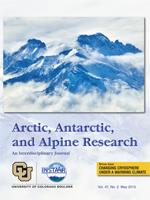Records of high resolution climate variability in the past are essential to understanding the climate change observed today. This is particularly true for Arctic regions, which are rapidly warming. Prior to instrumental data, proxy records can be extracted from high-latitude climate archives to provide critical records of past Arctic climate variability. Here, we investigate the feasibility of extracting records of climate and environmental variability from the skeleton of the crustose coralline alga Leptophytum foecundum from offshore the Sagavanirktok River in the Beaufort Sea. Although this alga forms an annually banded skeleton, age chronologies were established with difficulty due to the large uncalcified reproductive structures relative to low annual growth rates. Average measurements of skeletal Mg content, δ18Oalga values, and δ13Calga values were consistent among the analyzed specimens, but time series of these parameters only significantly correlated between two of the collected specimens for δ18Oalga. No clear trends in environmental variability explained the patterns in the skeletal geochemistry over time. This suggests that ambient seawater combined with freshwater from the Sagavanirktok River drives the geochemistry of L. foecundum at this site. Thus, coralline algal specimens located near variable sources of low-salinity waters are not ideal organisms to use as proxy archives.
How to translate text using browser tools
1 May 2015
Does the Coralline Alga Leptophytum foecundum (Kjellman) Capture Paleoenvironmental Variability in the Arctic Ocean?
Laurie Bougeois,
Branwen Williams,
Jochen Halfar,
Brenda Konar,
Walter Adey,
Andreas Kronz,
Ulrich G. Wortmann





